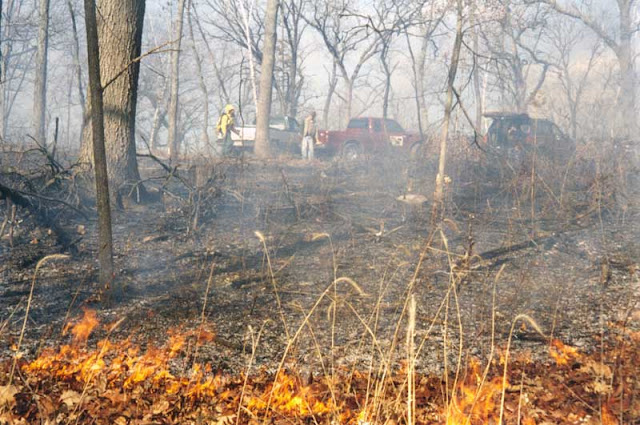Unusual fall weather for a savanna burn November 6, 2004
What's happened to those great fall days that were so perfect for savanna and oak woodland burns?
The last several years it has been difficult to find a good day for a woods or savanna burn.
Since my memory may be faulty, I've been reviewing my notes from burns from earlier years. How about this:
On November 6, 2004 the temperature at 2 PM was 75-78 F and the R.H. was 18-20% (measured by Kestrel). I question whether the Kestrel is accurate at that low R.H., but there were no clouds and the air was clear and sunny. Ideal conditions for a savanna burn. And we didn't need a permit!
The map shows what we burned. The blue dashed line along the south side of the burn unit represents a new trail we call the Mid Savanna Trail. We put that in along the middle of Unit 11 savanna in order to provide access to this area. That trail ends at the East Overlook and provides a short-cut for people who want a smaller hike.
According to my pencil marks, the burn coverage was very good. The few small open circles are areas that had brush patches. Not brambles, because the fire burned right through them.
We had 10 people, part paid and part volunteers. We started lighting in the far east end of the burn unit. There were two burn lines, one moving south and west along the blue dotted fire break, and the other moving north and west along the north side of Unit 19 and then east along the South Fire Break. Once the whole periphery had been blackened, extensive interior lighting was done. The burn boss surveyed the area and directed drip torches to areas needing fire.
We had two pumper units. One was a high-power rig from the Prairie Enthusiasts, and the other was an electrically operated pump on the back of our Kubota tractor that Paul Michler had made.
With the low humidity it was perhaps not surprising that we had a flaming tree, a large bur oak in Unit 10. We used the high-power pump to put this fire out. The Kubota rig was used to put out smokers that were too near the fire line.
We started lighting at 10:45 AM, and finished at 1:15 PM. Interior lighting and mop-up took until 3 PM.
A great burn! Will we ever see November conditions like this again?
The last several years it has been difficult to find a good day for a woods or savanna burn.
Since my memory may be faulty, I've been reviewing my notes from burns from earlier years. How about this:
On November 6, 2004 the temperature at 2 PM was 75-78 F and the R.H. was 18-20% (measured by Kestrel). I question whether the Kestrel is accurate at that low R.H., but there were no clouds and the air was clear and sunny. Ideal conditions for a savanna burn. And we didn't need a permit!
According to my pencil marks, the burn coverage was very good. The few small open circles are areas that had brush patches. Not brambles, because the fire burned right through them.
We had 10 people, part paid and part volunteers. We started lighting in the far east end of the burn unit. There were two burn lines, one moving south and west along the blue dotted fire break, and the other moving north and west along the north side of Unit 19 and then east along the South Fire Break. Once the whole periphery had been blackened, extensive interior lighting was done. The burn boss surveyed the area and directed drip torches to areas needing fire.
 |
| Kathie lighting along the Mid Savanna Trail |
We had two pumper units. One was a high-power rig from the Prairie Enthusiasts, and the other was an electrically operated pump on the back of our Kubota tractor that Paul Michler had made.
With the low humidity it was perhaps not surprising that we had a flaming tree, a large bur oak in Unit 10. We used the high-power pump to put this fire out. The Kubota rig was used to put out smokers that were too near the fire line.
 |
| This flaming tree was mostly alive; only the dead side branch was on fire |
 |
| Using TPE's high-pressure pumper unit to extinguish the fire. An extension ladder is being used. |
We started lighting at 10:45 AM, and finished at 1:15 PM. Interior lighting and mop-up took until 3 PM.
A great burn! Will we ever see November conditions like this again?
 |
| Paul Michler made this pumper unit. The electrical pump works off the tractor battery. This whole unit was put together for less than $400. |



















